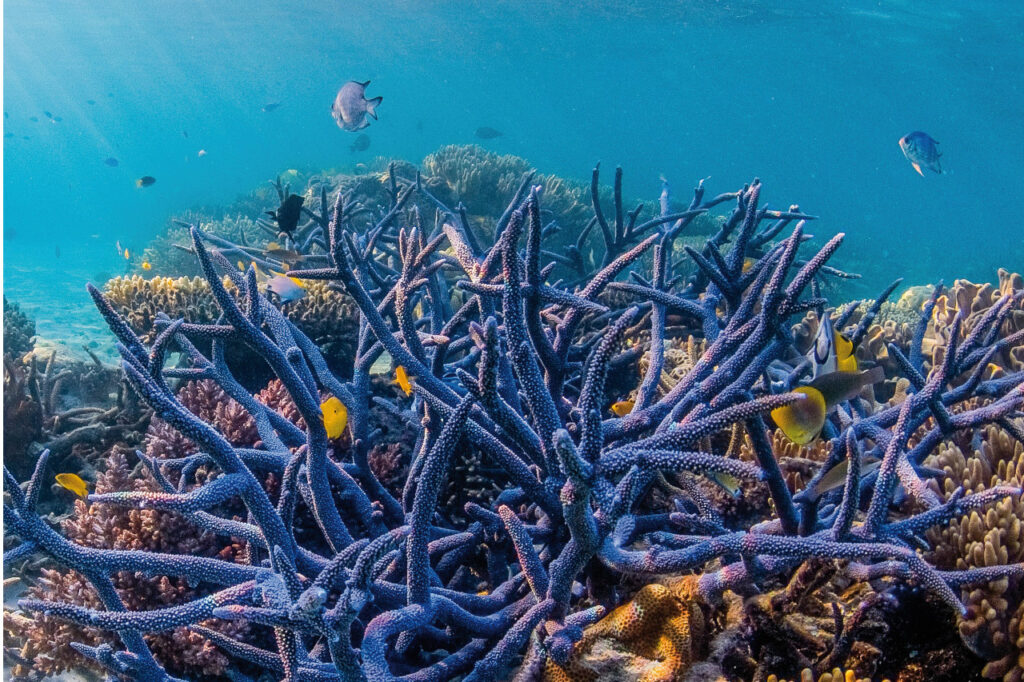[LUM#3] Coral reefs in danger
They are under threat all over the world. How can we better preserve coral reefs, irreplaceable refuges for marine life? A scientific expedition has come up with some new ideas.

New Caledonia, the Tonga Islands, French Polynesia: this is not a list of idyllic destinations for your next vacation, but the research grounds of the Pristine project. In these dream islands, home to some of the planet's last oceanic refuges, a team of marine biologists has dived in to encounter a teeming life. Their objective: to diagnose the state of health of coral ecosystems.
Protecting marine life
Because these havens of life are under threat. " The latest scientific assessments are alarming: 75% of the world's reefs are under threat today, with 60% under direct and immediate threat. By 2050, this figure will have risen to 100%," warns David Mouillot of the Marbec laboratory.
To protect marine life, you need to know about it. " Quasi-pristine sites have the advantage of providing a reference point, where we can measure the state of biodiversity in the absence of any human intervention. This reference will then serve as a yardstick for measuring the impact of human presence around the world, as well as for measuring the effectiveness of marine protected areas.
Diving on the Actéon islands in Polynesia, the Minerve reefs in Tonga and the New Caledonia archipelago, the researchers had their share of surprises. Beneath the waves of the Pacific, they witnessed a forgotten spectacle... " Sharks in abundance, gigantic groupers, napoleon fish, humpback parrots: life abounds here. Some of the species that thrive here are in danger of extinction elsewhere," describes David Mouillot.
An extraordinary biomass: over one tonne of fish per hectare. That's around 70% more than you'd find in any other protected area on the planet. A spectacular difference. Why this explosion of life? Or rather, why are fish so scarce in other protected areas?
Human, too close to human
For the scientists behind the Pristine project, the answer is clear: it's the proximity of man that's responsible for the disappearance of the fish. A factor they have carefully measured. " Coral reefs are closer to man than previously thought. Half of the world's reefs are less than 30 minutes' travel from a village, a market... Reefs that are therefore under very strong pressure. As a result, 90% of the world's large predators - tuna and shark - have disappeared from these areas.
Only reefs far enough away from human communities would be safe, says the study, which places the critical threshold at around 12 hours' travel time. Today, such reefs are extremely rare. " Worldwide, barely 1% of coral reefs are safe, i.e. beyond the 12-hour travel time. This is the other major finding of the study: the rarity of these natural refuges. They are found mainly in the middle of the Indian Ocean and in the Pacific.
These areas, vital for biodiversity, are the responsibility of Western countries. Most of these last refuges for marine life belong to England, the United States and France: New Caledonia alone accounts for a quarter of the planet's isolated reefs...
Poorly protected biodiversity
A particularly heavy responsibility, given the state of degradation of marine biodiversity. Although marine protected areas exist almost everywhere in the world, their effectiveness is partly called into question by the conclusions of the Pristine project. " These areas are useful, in particular to allow small fauna to replenish their stocks. But they are insufficient. They provide inadequate protection for certain species, particularly large predators. The main problem is that they are too close to human activity. They are also too small to cover the entire vital territory of threatened species.
Although efforts are being made to create new protected areas, according to David Mouillot, they are still far from sufficient. This is all the more true given the tendency to create these areas as far away as possible from zones likely to give rise to conflicts of interest with coastal users: fishermen, tourists, etc. "Public authorities thus create reserves on sites that don't really require protection", sums up the researcher. Public authorities thus create reserves on sites that don't really require protection ", sums up the researcher.
The public authorities are ill-informed, and sometimes unaware of the value of this irreplaceable natural heritage. " As scientists, we have a role to play in informing and raising awareness, in order to move political lines ". In New Caledonia, the d'Entrecasteaux reefs were classified as a protected area following the Pristine project.
What are the solutions for preserving marine life?
Asking all the countries concerned to invest more? " We can hardly ask developing countries to make additional efforts. How can we deny access to the sea to villages that make their living from fishing? On the other hand, industrialized countries must offer drastic levels of protection on their territories.
What kind of protection? " Create "No entry" zones where it will be forbidden to enter. Or even reverse the logic, creating areas authorized for fishing, and sanctuarizing the other areas by default. An experiment that could prove its worth on a regional scale - why not use New Caledonia or Corsica as examples? And demonstrate that the fishermen themselves will ultimately benefit from these measures, which are the only way to replenish fish stocks.
UM podcasts are now available on your favorite platforms (Spotify, Deezer, Apple podcasts, Amazon Music...).